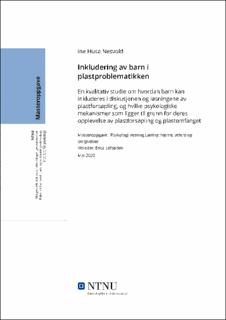| dc.contributor.advisor | Löfström, Erica | |
| dc.contributor.author | Nesvold, Ine Husa | |
| dc.date.accessioned | 2021-09-13T16:18:12Z | |
| dc.date.available | 2021-09-13T16:18:12Z | |
| dc.date.issued | 2020 | |
| dc.identifier | no.ntnu:inspera:55448216:21627686 | |
| dc.identifier.uri | https://hdl.handle.net/11250/2776038 | |
| dc.description.abstract | Noen av de største utfordringene verden står ovenfor i dag omhandler klima og miljø, og hvordan vi kan ta best vare på jordkloden. I løpet av de siste årene har klimaendringer fått et økt fokus, både i forskning og i media, og store deler av dette fokuset har omhandlet voksne og deres holdninger og atferd. Likevel ser vi et økende klimaengasjement hos barn og unge som ikke ser ut til å stoppe med det første. Denne kvalitative studien undersøker hvordan et strukturert workshop-opplegg kan brukes for å inkludere barn i diskusjonen og løsninger av plastforsøpling, samt hvilke psykologiske mekanismer som ligger til grunn for barns opplevelse av plastforsøpling i naturen. Med utgangspunkt i et 5.klassetrinn er datamaterialet hentet inn gjennom metodologien Nature in Your Face som ga strukturen til workshop-opplegget, i tillegg til gjennom gruppeintervjuer av de 36 elevene som deltok. Intervjuene er analysert ved bruk av tematisk analyse, og resultatene viser at det er tre overordnede temaer som oppsummerer hvordan barn opplever plast og plastforsøpling: bekymring og frustrasjon, omfanget av plast og plast oppleves som positivt og negativt. Disse temaene knyttes så opp mot klimaangst, benektelse, self-efficacy og kognitiv dissonans. Resultatene av workshopen peker på at øko-visualiseringer kan utløse en reaksjon og et engasjement som kan videreføres gjennom tre ulike faser. Disse fasene kan videre føre til idéer og løsninger for plastproblematikken, men er avhengig av å være godt strukturert for å få utløp for sitt potensiale. | |
| dc.description.abstract | Environmental challenges and how we care our planet are some of the greatest challenges the world is up against at this moment. In the last few years these challenges have gotten an increased focus in both research and the media, and this focus mostly consist of the attitudes and behavior of adults. However, we have witnessed an environmental engagement amongst children and youth which seem to be increasing rapidly. This qualitative study examines how a structured workshop can be used to engage children in the discussion of plastic littering and to include them in solving this challenge. The study also examines which psychological mechanisms that underpins how children perceive the increasing amount of plastic littering in nature. Based on 36 fifth graders the study´s data material is obtained by using Nature in Your Face as a structure for the workshop, as well as by using group interviews. The interviews were analyzed by using thematic analysis and the results indicate that there are three prominent themes which summarize how children perceive the amount of plastics used and plastic littering: fear and frustration, the amount of plastics, and plastic is perceived as positive and negative. These themes can be linked to eco-anxiety, denial, self-efficacy and cognitive dissonance. The result of the workshop indicates that eco-visualizations can create an emotional response and an engagement which can be transformed to the next three phases of the workshop. These three phases can lead to ideas and solutions to plastic littering, but they need to be well conducted so that their potential is obtained. | |
| dc.language | | |
| dc.publisher | NTNU | |
| dc.title | Inkludering av barn i plastproblematikken | |
| dc.type | Master thesis | |
